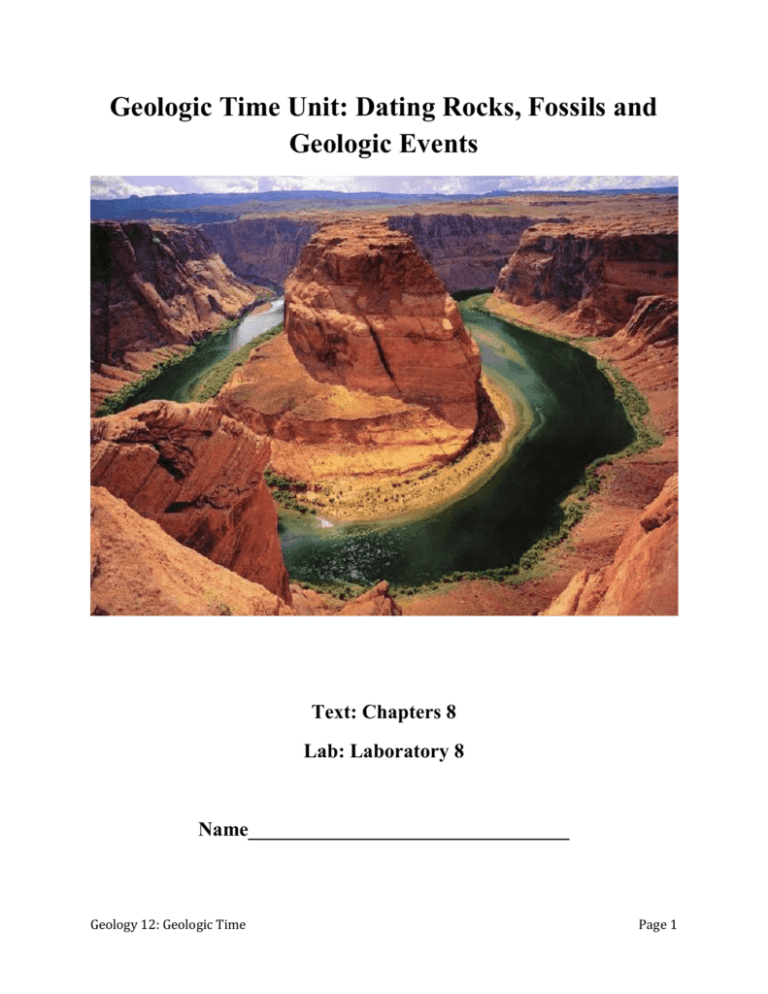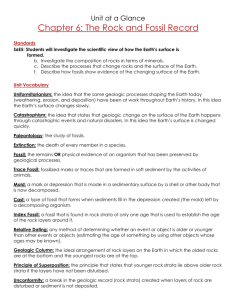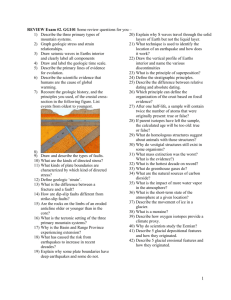File
advertisement

Geologic Time Unit: Dating Rocks, Fossils and Geologic Events Text: Chapters 8 Lab: Laboratory 8 Name________________________________ Geology 12: Geologic Time Page 1 Geologic Time Unit Purpose: To classify metamorphic rocks and features by their physical and chemical properties. -By the end of this unit, students are expected to be able to: 1. Relate relative age dating to the development of the Geological Time Scale: a) Define relative age b) Determine the relative ages of different formations using available resources c) Give examples of unconformities and interpret their significance d) The sequence of major events in Earth’s history e) Determine the geological history of Earth using relative dating techniques 2. Contrast relative and absolute dating: a) Define absolute dating b) Explain how half-lives of radioactive elements are used in estimating the ages of materials. c) Evaluate the sources of error in estimating a radiometric age. d) Use the Geological Time Scale to help interpret the history of a sequence of rocks. 3. Relate the fossil record to the Geological Time Scale (Many of the following points were covered in the Sedimentary Rock Unit): a) Define fossil and identify conditions necessary for their formation. b) Describe the process of original preservation. c) Differntiate between fossils and trace fossils d) Analyze the characteristics of a fossil that would make it an index fossil. e) Relate principles of evolution to the interpretation of the fossil record. f) Describe the probable environment suggested by a fossil assemblage. g) Correlate sequences of rock using index fossils or rock data. Geology 12: Geologic Time Page 2 Geology 12: Geologic Time Part A: The Geologic Time Scale Today, we know that Earth is approximately 4.6 billion years old. How do we know this? _____________________________________________________________________________________ _____________________________________________________________________________________ In this unit we will look at the scientific principles developed to make sense of the clues Earth provides us with to its origins and transformations. Part B: Relative Dating Principles Relative Dating relates the age of one object to another. It can’t provide an actual age for a geologic feature, only a relative one (older or younger than another feature). Although relative dating techniques were developed in the 1800s, they are still widely used today as they allow for rocks to be placed in their sequence of formation. 1. Uniformitarianism ________________________________________________ ________________________________________________ ________________________________________________ *The key to understanding the past is the present! 2. Principle of Original Horizontality ________________________________________________ ________________________________________________ _____________________________________________________________________________________ _____________________________________________________________________________________ Geology 12: Geologic Time Page 3 3. Law of Superposition _____________________________________________________________________________________ _____________________________________________________________________________________ 4. Principle of Cross Cutting Relations ______________________________________________________ ______________________________________________________ What is the correct order (oldest to youngest) for the following features in the diagram below? __1__ Sandstone _____ Shale _____ Dyke B _____ Fault A _____ Dyke A _____ Batholith _____ Conglomerate _____ Fault B Geology 12: Geologic Time Page 4 5. Inclusions _____________________________________________________________________________________ _____________________________________________________________________________________ _____________________________________________________________________________________ 6. Unconformities Rock layers deposited without interruption in the sequence are called conformable. However, no sedimentary strata is complete as erosion can occur and there are several ways for the deposition of strata to be interrupted. The resulting gaps in the rock sequence are called unconformities. There are three types of unconformities: Siccar Point, Scotland. This unconformity was used to support the idea of Uniformitarianism. Geology 12: Geologic Time Page 5 a) Angular Unconformity: Tilted or folded sedimentary rocks covered by younger, horizontal strata. Indicates that deformation and erosion occurred while deposition was interrupted. b) Disconformity Non-deposition or erosion means that parallel strata are separated by an unknown length of time. Difficult to spot as strata are horizontal, often of the same rock type and little evidence of erosion is visible. Geology 12: Geologic Time Page 6 c) Nonconformity Break in strata separates older metamorphic or intrusive igneous rock from younger sedimentary strata. Uplifting and erosion are necessary to expose the metamorphic or intrusive igneous rocks. *Try Relative Dating Practice and then Activity 8.1 Part C: Rock Layer Correlation To fill in gaps in the geologic time scale, rocks of similar ages in different regions on Earth can be correlated. This can be done on a small scale by simply walking around outcrops and noting the position of a bed in a sequence of strata. However, on a larger scale other tools must be used: 1. Index Fossils Fossils can be used to estimate the age of strata in which they are found due to the Principle of Fossil Succession: _____________________________________________________________________________________ _____________________________________________________________________________________ _____________________________________________________________________________________ This idea is based on three assumptions: a) Life has varied over time. b) Successive forms of life can be distinguished from one another c) The relative ages of life forms can be determined. Geology 12: Geologic Time Page 7 In this process, Index Fossils are very useful as they have characteristics that allow strata to be more easily dated. In particular, these fossilized organisms were: a) ________________________________ __________________________________ b) ________________________________ __________________________________ c) ________________________________ __________________________________ d) ________________________________ __________________________________ Typically a variety of index fossils are used to date a strata. How else could fossils be useful in reconstructing the history of Earth? _____________________________________________________________________________________ 2. Index Strata Perform the same function as index fossils and generally have the same characteristics. *Try Activity 8.2 Use Index Fossils to Date Rocks and Events Part D: Absolute Age Dating Absolute dating techniques discover the numerical age of geologic events. 1. Radioactive Decay Radioactive Isotopes: _____________________________________________________________ _____________________________________________________________ _____________________________________________________________ _____________________________________________________________ The decay of radioactive isotopes occurs at a known rate that is not affected by environmental factors. Geology 12: Geologic Time Page 8 2. Half-Life Half-life is the time it takes for half of the nuclei in a sample to decay. If the half-life if known and the parent/daughter ratio can be determined, the age of a sample can be calculated. *Try Activity 8.3 Absolute Dating of Rocks and Fossils Part E: The Geologic Time Scale Through combining the relative and absolute dating techniques above scientists have been able to divide the history of Earth into distinct units, which are collectively known as the Geological Time Scale. The Geologic Time Scale to the right is from your lab book, Figure 8.9. *Try the following: Activity 8.4 Infer Geologic History from a New Mexico Outcrop Activity 8.5 Infer Geologic History from a Pennsylvania Outcrop Activity 8.6 CSI Arizona Activity 8.7 Subsurface Geology Inferred from Well Data Geology 12: Geologic Time Page 9









